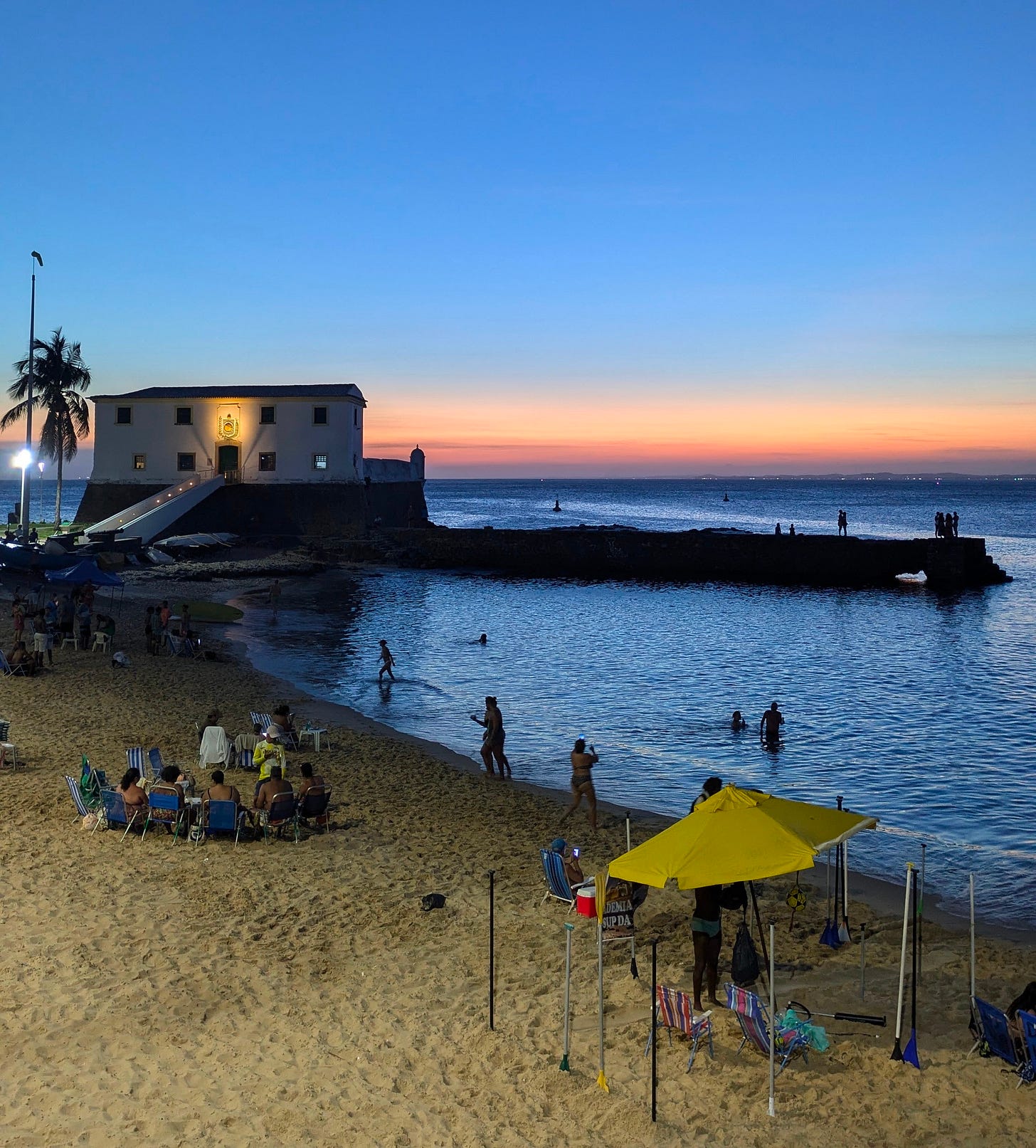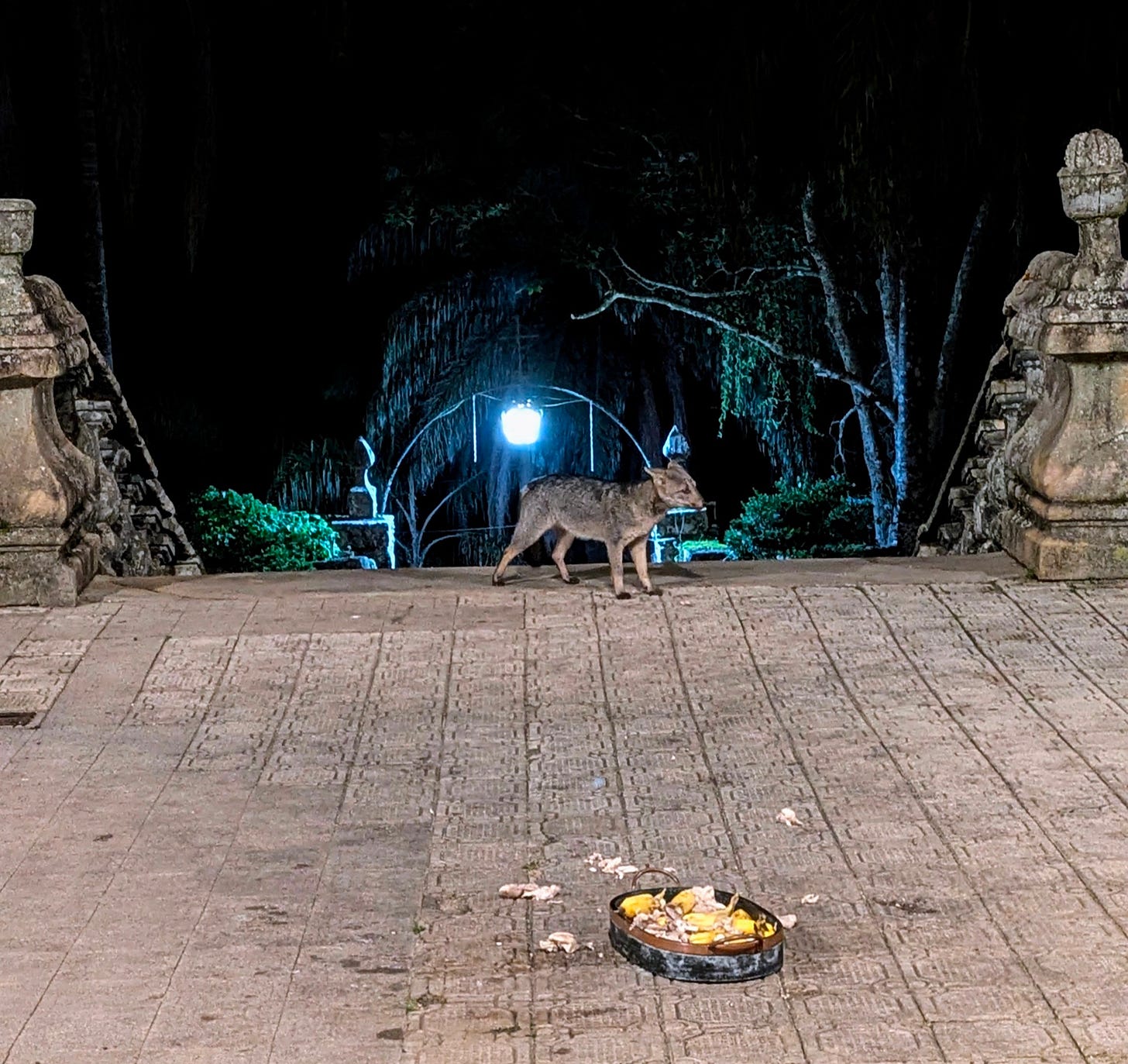I missed the cosiness of winter, but just for a minute
A road trip along the northeast to see Brazil's best beaches; wolf spotting in a spooky monastery.
Maybe it makes me a bit of a freak, but I quite like Januaries. Yes, in northern Europe it’s cold and dark for most of the day, everyone becomes sick and insular and miserable, and it can be hard to convince people to go out so much (myself included). But I like the quieter days and the chance to hibernate from time to time, the chance to sleep in more and watch films on the sofa. Cosiness. There are plenty of Scandinavian words for it; Katherine May calls it Wintering and by some theories it is a healthy part of our human annual cycle.
It goes without saying that South America experiences seasons very differently to Europe. Most of the countries we’ve been to are subtropical and therefore have hot summers and mild winters (bliss). And where it gets more tropical of course, the seasons mainly fall into two categories: wet and hot, and hot and dry.
All this is to say, don't hate me but it’s been two whole years since Dave and I experienced winter – an active choice made by departing Europe in early Autumn 2023 and by following the sun from south to north in Latin America. I really shouldn’t tempt fate but I’m quietly smug at how well we’ve managed to avoid any cold or very wet weather in the time we’ve been travelling. An anomaly here being the Bolivian salt flats, where the temperature fell to minus ten and below (and oh did we suffer in those hostels), but the sunshine was still glorious and super strong, which admittedly was a recipe for sunburn at such high altitude.
Even in Antarctica last January we still felt the benefits of summer – bright, clear skies and almost endless daylight. In smug summary, we’ve avoided the negative aspects of winter: there have been no short, dark wintery days of any kind, and I’m definitely a happier, more energised person for it.
Even so, in these early days of 2025, I do feel a tiny bit nostalgic for winter nights spent on the sofa under a duvet. Don’t get me wrong, we still have the odd night in eating home-cooked vegetables and watching Netflix – we’ve been travelling a long time and I’d expire if we didn’t. But there’s not the same need (or the excuse, maybe) to while away a Sunday afternoon in front of the TV or with a book, feeling cosy. I know in reality those kinds of afternoons probably happen about once or twice in a winter for me in normal life, but photos of friends all wrapped up drinking hot chocolate or mulled wine has triggered just a twinge of envy all the same.
The past week in Rio has been about as close to sitting still and relaxing as it gets for me and Dave on this trip – with all the city’s major tourist activities ticked off at least once or twice it gave us licence to be lazy, catching up on sleep and spending our afternoons on the beach. We caught up on some telly in the evenings and with friends on the phone, too, although I’d be lying if I said we’d stayed indoors much eating vegetables – even after several weeks spent in this city there are still too many great bars and restaurants to tick off. It’s been a very welcome break in proceedings, a lovely start to the year and very classically “holiday” in spirit. So maybe I have had my January slow-down fix after all.
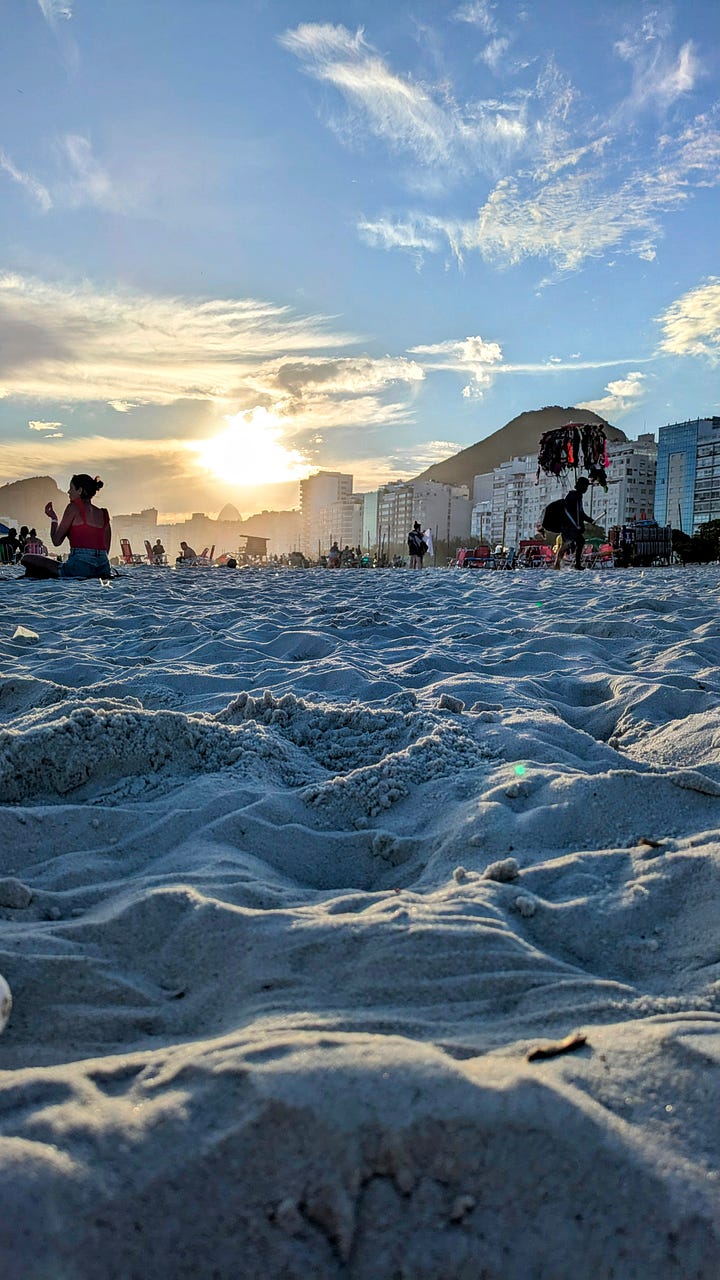
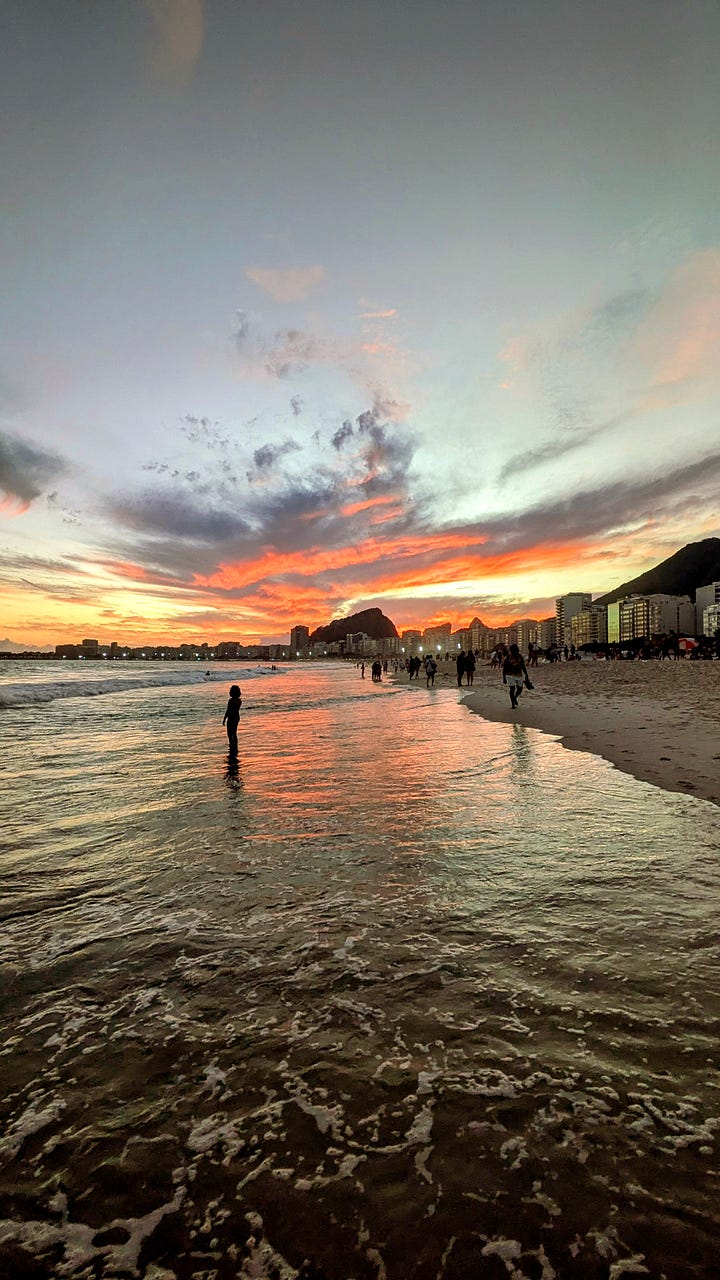
The other reason I quite like January is the sense of a fresh start it brings. Some of my friends get that feeling with each September – for them, the back-to-school rush of closed-toe shoes, fresh notebooks and sharpened pencils marks a good moment to think about future goals. For me it’s the turning of the calendar into a whole new year – it makes me hopeful for all the exciting things that could happen.
I definitely felt it last year, watching the fireworks in Valparaiso, Chile, with the knowledge that most of our backpacking months were still ahead of us. But this January feels bittersweet, because I know this is the year we’ll most likely have to think about a return to London and normality, whatever that looks like. There are friends to see, parties to attend, storage boxes to reclaim and jobs to think about (for Dave, anyway. I endeavour to continue with my bohemian freelance lifestyle and avoid a real job for the foreseeable, thanks).
And while it won’t be for a few months yet – so don’t get too excited at the thought of throwing our stuff down from your loft – I’m still sad about it. But as Dave likes to tell me via the the wisdom of the British comedian John Robins: if you’ve constantly got one foot in the past and one in the future, you’re pissing all over the present. So after a brief mourning period of me whinging to him (Dave, not John Robins) that I’m not ready to go home yet and might never be, I’m trying to flip that mopey feeling into a reminder to soak up and appreciate every fun moment that we still have out here. I’ll admit I’ve been guilty of taking this amazing lifestyle a tiny bit for granted from time to time. No more!

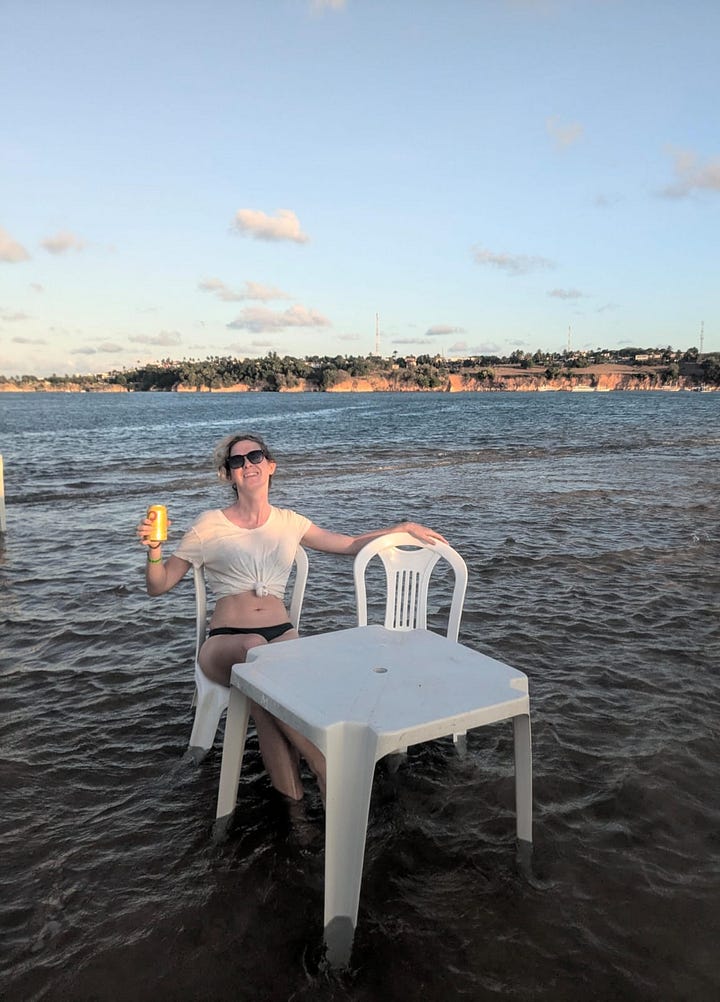
With all that said and at the risk of pissing on the present, I do need to tell you about our race around northern Brazil back in December. After our trip to the Brazilian Pantanal in the south, we took an unorthodox loop up towards the northeast coast, stopping in Brasilia for a brief spell of sickness and architecture, and with it some of the longest buses we’re likely to endure this whole trip (30 hours is a lot of roadside buffets, let me tell you).
Our goal was to see the best of Bahia and the northeast before heading back down along the coast towards Rio for Christmas. I am a sea creature by nature and we had been steadily cruising Brazil’s vast interior for many weeks: it was high time we saw the sea again for some rebalance. We also timed it with the intention of intercepting our Argentinian friends, Sebastian and Giselle, who were taking their own mini backpacking tour of the north coast.
I remember months ago some Brazilians told us that the further north you go, the better the beaches become – an exciting prospect, since the ones we'd already seen around Rio and the south were spectacular already. The coastline from Salvador in Bahia and all the way up to Rio Grande do Norte on the country's top northeastern corner is famous for having some of the best beaches on the continent (maybe the world?) and a very different culture to the south with a much stronger Afro-Brazilian influence – think samba, capoeira and moqueca seafood stews.
We started in Salvador, which was a shock of colour and celebration after the concrete city plan of Brasilia and its much more monochrome hipster dress code. We decided to join an English language walking tour to get a feel for the city and learn a little about its history.
Salvador was the first capital of Brazil when it became a Portuguese colony in 1549. It developed into a huge port for sugar trading, and also, sadly, African slaves. The first ever slave market was held in Salvador. But more fool the Portuguese, because they eventually brought so many slaves over to the new colony to work that the slaves soon outnumbered them and successfully rebelled.
Today Salvador still has the largest Black population of any city outside of the African continent and Afro-Brazilian culture can be felt everywhere. We happened to arrive on Black Consciousness Day, a national holiday to mark the murder of Zumbi dos Palmares, and the bars were heaving with people partying and playing live music, but then to be honest that's the vibe every week in Salvador.
Zumbi was a descendant of Imbangala warriors from Angola who became a leader for rebellion against slavery. He famously helped accommodate runaway Black slaves as well as Arabs, indigenous people and Jews (sounds like a bad time to be anything but Portuguese Catholic in Brazil) but he was captured and beheaded in 1695.
Salvador is stunning but clearly still very socially divided – brightly coloured Portuguese buildings in the centre are now hugely expensive tourist restaurants, meanwhile our guide told us more than 40 per cent of Salvadorians live in the favelas lining the city. Drugs and homelessness are clearly big problems here. For these reasons it's not wise to walk around some areas after dark – and certain places are best avoided in the daytime, too… something we learned when a police car stopped us walking down the hill towards the marina one day. They offered to give us a ride instead – which did create a bit of a tough call (is this how we die? Or that?) but ultimately they were very jolly and didn't kidnap us.
From Salvador, we took another long bus all the way up to Natal and a shorter local bus across to Pipa Beach, where we found the Argentines.
We met Sebastian during the very first week of our trip back in October 2023. He was our Airbnb host in Bahía Blanca and kindly took us to his favourite bar and introduced us to mate culture (as in the Argentinian tea, not mateship in an Australian sense) the following morning. He's been kind and generous to us over the last 15 months and it's been fun to hang out a few times in various cities. But here's the thing about accidentally going on holiday with people you don’t know that well: sometimes it just ends up being a bit weird.
It’s not that anything bad happened – we had a great time thanks to the glorious setting. But there's nothing quite like cohabiting with someone new, albeit temporarily, to highlight the differences between you. We already knew we had contrasting politics – Sebastian is a vocal Milei supporter and that in itself is fascinating and horrifying to hear about in equal measure. What was much trickier to navigate during our week spent together by the beach was that the four of us had very different approaches to holidaying, it turned out.
For me and Dave, relaxing by the beach usually means reclining on a sun lounger with a beer and a book for several hours. Sebastian is not so much of a relaxer. He prefers an efficient approach to sightseeing: an organised buggy tour the four of us took to see the dunes north of Natal reached its end destination two hours ahead of schedule because Sebastian didn’t see the point of hanging around to enjoy the views, for example. Over several nights with the four of us sharing an apartment together in Natal, I tried really hard to loosen the atmosphere by proposing cocktails, card games, easy-win conversation topics about their favourite things (asado, dogs, laughing at Brazilians) but ultimately I got the impression Sebastian was happiest working remotely on his laptop indoors while simultaneously securing Black Friday deals for his mother in law. Each to their own.
On the plus side, we would never have gone to Pipa Beach if it hadn’t been for them – the place is a popular spot for Argentinian surfers but wasn’t on our radar up until that point. And it was a really special place – maybe one of my favourites of the whole trip.
Pipa town itself is small but the strong presence of Argentine holidaymakers means it has plenty of asado restaurants and well-loved bars alongside hipster brunch cafés serving overpriced coffee. We loved it.
I will admit I had a momentary panic on arrival at our hostel, where we were greeted by a one-armed, one-legged surfer who had to wake up his stoned roommate to let us in at midday. I caught a glimpse into their stoner hellnest and shared bathroom hellpit and hyperventilated just briefly, but actually our own private room was lovely, clean and spacious, and most importantly cost us just £6 a night.
But the best thing about Pipa was, predictably, its beaches. There are three great ones within close reach of town and we tested them all out, starting with Praia de Pipa right in the centre (fun, busy, crazy warm, calm water and bars with a sunset view); Praia do Amor (a bigger version of that with fewer people, more sun loungers and big, crashing waves) and Praia do Madeiro, where we bobbed in the warm waves while spinner dolphins – so named for the way they spin out of the water when hunting – surrounded us. It seemed like the small pod might have been using our loose line of humans as a barrier to corner the fish; they’d race down and into the shallows towards us before jumping out of the water to catch them. The whole beach was rooting for them, cheering every time they did it.
After a few days in Pipa, the four of us shared an Uber back up to Natal, a huge city where the beaches are less pure but the seas are warm and clear all the same. Purest of all, Natal (which literally translates as Christmas) goes in very hard for Christmas (“Natal em Natal”) and we enjoyed walking through a deranged number of supersized festive light installations. The Argentinians seemed genuinely charmed by it all and it was quite sweet watching them facetime their families to show them. Before coming to South America I had assumed that every Christian country did some kind of Oxford Street-esque Christmas display in December, but now I realise it's very much a capitalist thing (duh) – hence nothing so fantastically garish as this in Argentina, and as we found last year, very little by way of Christmas trees in Chile.
We said goodbye to Sebastian and Giselle after a few nights there, as they were continuing north towards Fortaleza and Dave and I were heading south.
Back on the road again and free to be as lazy and thirsty as we liked, we took a short bus down to Porto de Galinhas, aka the port of chickens, for some swimming, snorkelling and grazing. Galinhas is another cute holiday beach town, albeit much more Brazilian with huge families eating huge buffets at all hours of the day, but the special thing about that whole section of coastline is the reef that hugs it all the way down. In Galinhas you can swim and walk across to see natural pools brimming with fish during low tide. And, because it's Brazil, there's always a floating bar somewhere nearby.
Another two hours south to Maragogi – we took an Uber again because it was super cheap and the buses weren't direct – where this time we took a little boat trip out to snorkel along the reef with angel fish in some of the clearest water I've seen. The coastline is tagged on Google as the “Brazilian Caribbean”, and it's easy to see why.
From Maragogi, we hopped down once more to Maceió (where we accidentally got in the way of a policeman’s gun), a very monied-feeling city with more beautiful beaches and sandbar walkways to visit in low tide. And then, after some more sushi and caipirinhas, we retraced our steps back down to Salvador once again.
I can really recommend this little northeast highlights loop, it would make a great standalone two-week road trip for someone flying into Natal from Europe. You could hire a car, but the buses are also fine. Uber is also very affordable, even over long distances, which makes the transport a breeze. Sebastian and Giselle got onto an app called BlaBlaCar – kind of like Uber meets hitchhiking. They managed to catch a ride to Maragogi with it, but I didn't have any success, which makes me think building up a profile with good ratings must help. Not sure how one does that without first securing a ride…
From Salvador, we took another long bus south to Belo Horizonte, where much to Dave’s excitement we had the joy of staying in the second Ibis Budget of our trip in Brazil and possibly of my life. We charmed a bored receptionist who had been designated the nightshifts (and whom I suspect had greater ambitions) into storing our big bags for free for a few days while we took a detour out into the mountains to stay in a big haunted monastery for a couple of nights, because why not? But also because they have maned wolves.
Technically speaking maned wolves are not quite wolves, but they’re not quite foxes or dogs either – they’re unique, the only species in Chrysocyon genus. Maned wolves are characteristically similar to African wild dogs or painted wolves but they're tall like a wolf – around a metre high. There are only 17,000 of them left in the wild and most of those are found in the Cerrado region, where the Santuário do Caraça monastery sits.
Caraça was built in the 18th century as a monastery but it was also a school – a very fancy and possibly quite strange one, all the presidents went there – until 30 years ago when parts of it were burned down in a fire and it was rebuilt to become a nature reserve. It probably goes without saying that the place is pretty spooky. But it was unexpectedly comfortable and the food was just obscenely good.
Dave and I hiked the trails around the site by day and then stayed up to watch for the wolves at night. Decades ago, one of the Caraça’s resident monks realised that something or someone was raiding the monastery bins each night for food. He kept watch one night and discovered it was the local maned wolves – and a tradition began of leaving a tray of food out for them. Is it ethical? I think yes and no. The wolves are in no way tame, they're still very wild and hunt for themselves. But their habitat has been squeezed so much in the past few years – the Sanctuário is within a protected reserve now, but a lot of the surrounding region has been deforested. They're endangered, so I think why not give them a free school meal. Plus it brings ecotourism to the region, which in turn helps to protect their habitat. Win-win.
There were other guests staying at the monastery, but none had the stamina for game spotting that we have. It’s quite the flex but all my years of going to the Kruger have prepped me well for that. We sat very quietly on the church steps outside the monastery with a bottle of wine and started our vigil. One by one, people gave up and went to bed – and at around 1am on the first night we did the same. But on the second night, at around 9pm, we and a couple of others got super lucky and received several visits over the space of a couple of hours from two baby wolves who were super hungry for fermented chicken thighs. It was magical.
From the monastery it was a stomach-churning bus ride through the mountains again to Ouro Preto, a strange little town with not a huge amount going for it apart from pretty green views and old-school buildings that made it reminiscent of northern Portugal. That and the seemingly endless tat shops selling semi-precious stones from the nearby mines – apparently a big pre-Christmas attraction for Brazilians either seeking out the perfect gift or a way of casting spells on their least liked family members.
Dave will no doubt make disappointed noises when he reads this because he thinks there’s much more to Ouro Preto than this, but that’s because he is descended from Welshfolk and genetically much more at home on damp cobbled streets halfway up a mountain. It was pleasant, there were nice views, we ate some good food. I think it just reminded me a lot of one of those very twee towns in the British Lake District that have outdoor clothing shops and tearooms and not much else. It was a complicated time emotionally because the brief foray into mountain rain triggered my spiral of woe that Christmas could all be ruined with bad weather (it wasn’t).
Anyway where were we. From Ouro Preto we completed the mini loop back down to Belo Horizonte, an unexpectedly cool and modern city with the best food market I’ve seen in Latin America, set across four floors of a visually striking carpark (!) and later that same day, we took the final overnight bus down to Christmasland, aka Rio de Janeiro.
Funnily enough, we’ve ended up back in Belo Horizonte at the time of writing this newsletter. We're here just briefly while we wait for a flight up north, for reasons that will all be revealed next time. No time for hiding under the duvet with a book this January.
Travel bits and tips from this week
Arriving in Salvador the first time we stayed in this lovely Airbnb just outside the centre. On our return we stayed at the Solcity Hostel down in Barra, which is a nice area to be in for the beach and friendlier nightlife.
The people were friendly but the room wasn’t very clean, so when we extended our stay we moved onto the Sunflower Hostel which sounds nice but was run by miserable witches and I had a big argument with one of them over payment.
We ate and drank at B-Vegan in Barra (twice, so good! Even Dave liked it); Guapo Mexican Bar (jolly enough); Cafeteria Cheirin Bão (great cakes); Cafélier (beautiful terrace and great value food), Dona Xícara Café; Limousine (very fun down in Barra by the seafront); Oxe Drinks (sunset views in Barra) and apparently Dave also squeezed in a KFC.
In Pipa we stayed at Padang Hostel which gave a bad first impression but was actually great. And crazy cheap!
You’re spoilt for choice for places to eat and drink in Pipa but we did our darned best to try them all. A non-exhaustive list starts with brunch at Hygge cafe (tasty coffee and pastries, if a little pricey. Great dog); Orishas resto bar (nice setting overlooking the water), Bella Pizza (does what it says on the tin), Cabana da Carol (beach bar on Praia do Pipa with sunset views); Ta Massa (really good homemade pasta); Casa de Farinha Pipa (good and cheap coffee and pastries – we became regulars); Restaurante TerraMar (world’s biggest carbonara, decent burgers); Aprecie restaurant (a step up on the fancy scale. Dave had the richest gorgonzola and steak pasta [“I’d go so far as to say that’s one of the nicest things I’ve had in all of Brazil, do you remember the tasty globules of gorgonzola they put around the sides of the dish?”] and I had a very spicy thai green curry), and finally we enjoyed a very delicious cocktail at Nativos bar.
In Natal we shared a two-bedroom apartment with Giselle and Sebastian, which was caused a bit of stress for many reasons but mainly because the internet didn’t work.
We had a great buffet at Pinga Fogo, something of an institution in Natal (an entire room of sushi!); we visited Mar di Cor Food Park and Jardim Ponta Negra, both very cheerful evening street food markets, and we stuffed ourselves over several hours at Restaurante Miramar, to the north of Jacumã and the sand dunes.
Next it was onto Porto de Galinhas – this apartment was an absolute steal, although it might have been because of the huge apartment being constructed just outside of our window which they failed to mention.
Food was a bit hit and miss in PdG but we found good pasta at Mardioca, a very good value lunch buffet at Restaurante Farofa Fina, and tasty crepes at La Creperie.
In Maragogi we stayed at the Brecha Rooftop Hostel which was excellent value with a very good breakfast.
I can recommend Kaiun sushi and wine and Odoia for the its seafood risottos. We thought about going twice and wished we had. Instead we went to Corais do Maragogi for a mediocre pizza and it was fine.
Maceió was a little more high-end, but we found a pleasant Airbnb not far from the beach that was decent value. It had the most archaic washing machine I’ve ever seen (basically a bucket that plugged into the wall and span aggressively) and my clothes haven’t been the same since, but I’ll be honest I chose the apartment mostly for the photos of a cat in a waistcoat.
We ate and drank at the Villa Maceió Food Park, Restaurante Casa de Mainha,
Tooka do Sushi (super swish) and spent an afternoon at the very Christmassy Vila Rosa Café.
The first time we stayed in Belo Horizonte we stayed at another Ibis Budget, not to be mistaken with the Ibis Style… But spooky how identical everything is in every Ibis.
Then on our return we stayed slightly north of the centre in this very charming Airbnb. The area is full of beautiful decaying mansions that are in the process of being done up by artsy types and this was a prime example. Our apartment was huge!
The food market I mentioned is Mercado Novo – we stumbled upon it looking for a casual place to eat and were very excited to discover four storeys of boutique shops, bars and restaurants with people who looked much cooler and younger than us spilling out of them. Honestly the best market we’ve seen so far.
We also enjoyed: the Asian buffet at San Ro Restaurante Vegano e Vegetariano,
Speciali Trattoria Italian, and MIZU tapas and sushi.
In Ouro Preto we stayed in another Airbnb – this one was just a simple room in a house with a shared bathroom, but it was comfortable and metres from the centre of things.
There we ate and drank at the Café Esquina da Realeza, Escadabaixo Bar Cozinha Brasileira (twice), Restaurante Jacubas, Café da Escadinha, and O Único Lugar do Mundo - Casa Café.
And the Santuário do Caraça monastery was a bit of a treat, but it really exceeded expectations. We booked directly via Whatsapp.




